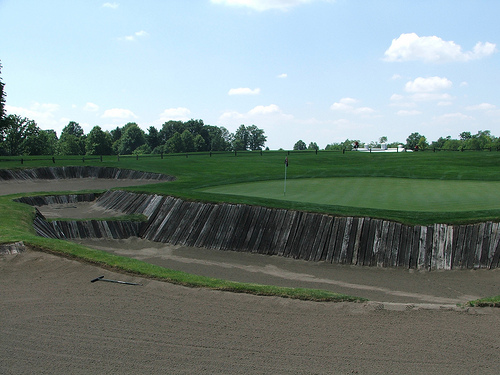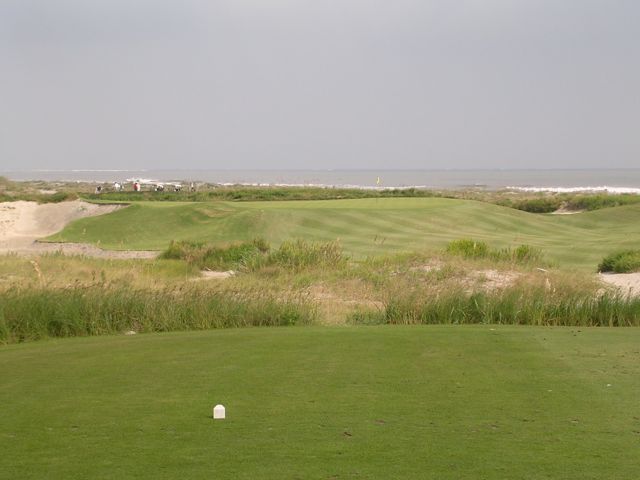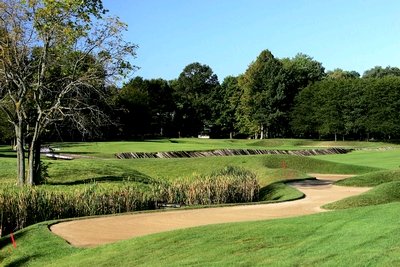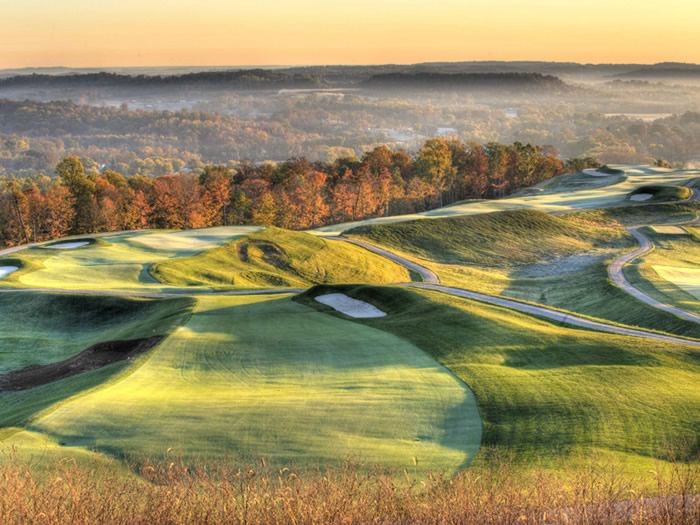
[NOTE: In honor of Pete Dye’s recent 92 birthday, we re-run this interview from several years ago.]
You could excuse Pete Dye if he tended to steer conversation toward the impressive collection of golf courses he’s built throughout his career, or if he happened to direct you to any of the many accolades he regularly receives.
His life’s work, after all, is legendary. Dye’s courses excite and exasperate the golf world like no one else’s and remain fixtures on the top 100 lists of virtually every golf publication in circulation. Six of his designs rate among Golfweek’s top 25 modern courses (those built since 1960) while seven populate Golf Digest’s latest list of 100 greatest in America regardless of era.
Dye’s ever-changing style has spawned imitators and driven design trends across five decades (we can thank him for island greens, pot bunkers and hazards lined with wooden bulkheads), and players around the world have taken almost perverse pleasure in having their scorecards disemboweled by his designs since the opening of the TPC Sawgrass Stadium Course in the early 1980’s.
Dye is just the seventh golf course architect to belong to the World Golf Hall of Fame (including Walter Travis and Old Tom Morris, who also qualify as players), and the only one from the contemporary era.
I spoke to Dye via phone from his home in Indianapolis for a magazine profile I was writing. I’ve had a chance to talk with him several times over the last few years and I’m always taken aback by his friendliness, candor and how generous he is with his time (at least to journalists). In talking with Dye, you always get unfiltered answers, they just might not be specific to the questions you ask.
Each time I’ve called (maybe it’s my timing) I’ve reached him at home and his wife Alice has answered and politely set up a time to call back later that evening. When I do call back, after dinner, Dye’s usually watching the Golf Channel (I envision him sitting in a recliner and speaking on a cordless phone).
The following are excerpts from our conversation. I began by asking some perfunctory questions about his affiliation with Indianapolis (a theme of the story), and his response was a modest but entertaining and well-rehearsed yarn about the early years, a sort of mythologized “Pete Dye: Origins.”
You’re from Ohio. How did Indianapolis come to be your home and the birthplace for your design career?
I went in (to the military) toward the end of the (World War II) and ended up at Fort Bragg (North Carolina), and when Mr. Truman dropped that present over there in Japan, I still had six months remaining in the service. So instead of jumping out of airplanes they made me green keeper there at the Fort Bragg course. They didn’t have any grass on the greens so I didn’t kill anything down there.
I was always interested in golf course maintenance. So when I married Alice and moved to Indianapolis (they met at Rollins College in Orlando) I still stayed pretty much the green chairman (at the Country Club of Indianapolis) and this and that and fussed around, and then I went up to Purdue (University) and took a bunch of short courses in turf—I never passed any of them, but I was always interested.
Then one time a farmer south of Indianapolis knew I was in that phase and called me to see if I knew anyone who could build him a nine-hole course—he didn’t have enough money and nobody wanted to do it. I had kind of a bad arms that summer, kind of a tennis elbow (and couldn’t play golf), so he said why don’t you come down (and do it). So Alice and I went down and built this nine-hole golf course—this was the summer of ’60, ’59 or ’60—but we get her finished (the course today is known as Dye’s Walk). And Alice made a nice card showing the golf course and how it played and sent it to all her friends. She sent one to Mr. (Richard) Tufts, who was president and owner of Pinehurst and past president of the USGA—Alice knew him pretty well because she won the North and South (Amateur) there at Pinehurst—and he wrote back after she sent the card and said it was wonderful that you kids built this nine-hole course, but don’t you think crossing the creek 13 times in nine holes is a little too much?

The Golf Club outside Columbus, Ohio (1967), was a stylistic breakthrough for Dye and American golf.
Then the following fall, Dr.. Harlan Hatcher, the president of the University of Michigan, was driving down from Ann Arbor south through Indianapolis and stopped and played this nine-hole course and I swear he must have had the greatest round that’s ever been played because he’s a 90’s shooter. He must have got over those 13 creeks somehow or another. But he’d been talking to (Robert) Trent Jones and Dick Wilson to build the new UM course, and after playing (my course) he called me—and I was peddling life insurance like the devil (at the time)—and I told him I didn’t know how to draw a plan and didn’t know how to do this (or that). But I went up and talked to him and ended up building the University of Michigan (Radrick) Course, and I’ve been building them ever since.
Several years later you built your own course, Crooked Stick.
After I build the University of Michigan course I built two or three smaller courses around different places in [Indianapolis], and then finally Alice—her family had some land—and I went out and optioned almost 500 acres just north of Indianapolis, which was out in the corn fields of course, and ran around town and gathered up 80 guys that put up $6000 each, and then I got the bank to loan us some money to build nine holes.
We had some lots (around the outside of the course) and sold a few of those and got enough money to build a second nine holes. It’s gone along for years. We went back there and built a little house just off the 18th hole…so we go back there in April or May and stay until October or November. It doesn’t make any difference where I live because the way I’m going I’m always building someplace where I don’t live. I can commute so it doesn’t make any difference, but we go back in the summertime.
Crooked Stick is a very personal project for you, isn’t it? A little like Ross at Pinehurst No. 2 where you can tinker with it over the years?
When I first started building golf courses, if they had a really fast green—I mean really fast, this was 1960—it would be 7 or 8 on the Stimpmeter. When Hogan won the Open at Merion, and when they’d play it at Oakmont, they were only 5 or 6 on the Stimpmeter. The grasses have totally changed the way greens have to be built, then the fairway grasses are different—everything’s different.
Everybody talks about the club and the ball, which they’ve totally lost—the USGA has lost complete control of them—but the grasses and the way you maintain golf courses from what they were in 1950 is just like night and day.
So I’ve gone back and modified Crooked Stick I think three times. I went down to the TPC in Jacksonville (Sawgrass)—I’ve been back there four times and they don’t have 72 holes, they only have 18, and I’ve been back four times to try to stay abreast of the way things have changed from an agronomical point of view. From the way they mow the greens and so forth, the way they mow the fairways, everything’s different. The golf course, from the grass point of view, continues to change.
Speaking of Crooked Stick and Sawgrass, you’ve always had an almost adversarial relationship with professional tournament golf, and so many of your courses have held high profile professional events. How does that affect you to know that your work is going to be publicly probed and maybe exposed by professional players?
When Nicklaus was hitting it so doggone far years ago he was hitting it 265 yards and a lady hit the ball maybe 145 yards. She still hits it 145 yards but now other players are hitting it 320, so there’s such a drastic separation from the front tees to the back tees. If a guy’s hitting it 300 yards on a par four and the thing’s 480 yards, then he’s hitting a 6- or 7-iron to the green. The old players, like Hogan at Merion hitting that 2-iron or whatever it was into the last hole—the USGA has changed golf so you rarely see a good player hit a drive and a long iron to a par four.
You almost can’t fight that. Most of the golf courses I’ve built, they’re going to have a pro tournament. Now you’ve got the guys that hit the ball 270 or 280 yards, and some of them 320, you’ve got a 50 yard base there (you’re) trying to protect in professional golf. It’s almost impossible. Where it used to be where Nicklaus was 265 and somebody was 240, you only had 25 [to protect]. Now it’s a 50-yard swing. Of course the tournament directors, whoever’s running the golf course, they move (the tees) up or back and those long hitters just carry everything. It’s really difficult to build a golf course (and) make it good enough for Joe Q. Public to play golf and still have something when (the pros) arrive.
How often, if at all, do you visit your early designs, most of them in Indiana?
I go back all the time to courses I’ve worked on around Indiana. I go back to Purdue (the Kampen Course)—I tell you, they had the Big 10 [Championships] up there four or five years ago and…only one guy could carry (a particular) far bunker out of the Big 10 (field). Three years later they had another intercollegiate [tournament] and 28 of them could carry it. Three years later! So the ball has changed that much in three years. So we’re going back to Purdue to get [the course] ready for the next tournament, and I don’t know if we can keep it under control or not. But I go back to most of the golf courses I’ve ever built and still hang around. They haven’t run me out of town yet.
Have developments in club and ball technology forced you to evolve stylistically as a designer?
“Every time I’ve gone back to like Harbour Town, where they have a PGA Tour [event], or I go back to the TPC [Sawgrass]—and go back and go back—I see the greens, the contours, you leave as much contour as you possibly can, but where you used to have a pin placement and the green ran off three inches every ten feet a few years ago, the (it went) down to two, and now I’m down to an inch and a quarter (slope) every ten feet to get a pin placement because of the speed of the greens.”
Those are renovations, but do you also design new courses, like French Lick, with the possibility in mind that there might be a professional tournament held there someday?
I did things down there [where] I just keep wondering have I lost my mind, because (I’m) trying to figure out what’s going to happen 20 years or 10 years or 5 years or 8 years down the line in golf. They’re hoping now they’re going to have a major event (someday). Now, I’m down there about 100 days or more trying to build that thing, and I’m trying to guess where the game of golf is going to be in the next 20 years…but it’s just a wild guess. I have no idea, I’m just wild guessing.
But I tried to make the thing thinking maybe in five years from now this might be what you have to have to make a golf course for a professional [event]. And that’s not right. It’s crazy to have to keep expanding because it just escalates the maintenance cost. But you hear about these kids hitting it 320, 330 yards–I mean, they’re not stronger than Palmer was in the 1960’s, it’s all equipment, I don’t care what they say. John Daly’s hitting the ball 30 yards farther than in 1991 and you know John Daly hasn’t made a pushup in the last 20 years.

We’ll see see how The Ocean Course at Kiawah Island handles technology when it hosts the 2012 PGA Championship.
Other than adding length, how else can you combat technology through design?
With the bunkering, you used to have by the way you raked it or did it, it was a hazard. Of course now with the PGA Tour and the USGA and Augusta, the sand has to be exactly the same so they don’t become a hazard to the good player anymore. So what I’ve done down in French Lick, I put bunkers on one side of the green and on the other side I made run-offs and made those run-offs have enough undulations [and] change so the guy’s going to chip it or putt it—it’s more of a shot for them. They had the Indiana PGA there last summer and those pros were having a fit trying to get up and down in two from those areas adjacent to the green that were cut short, and it was because of those undulations. While the higher handicap player is just trying to get down in three, so he’s going to have no problem, but the pros were having problems. I don’t know if I’ve hit a winner or not. We’ll find out.
Back to agronomics, I kept the fairways very narrow to 85 feet (because of the sprinkler heads, they’ll just cover the fairway to 85 fee—I used to make them 120 feet). There’s a new grass that came out from Texas A&M called turf-type fescue and you can cut it short and it will grow almost to be like zoysia and the ball sits up right on top of it. Pretty good. Then if you let it grow, the seed heads are really wonderful. I put it out in the rough and we worked out how we could maintain it with different water control than the fairway. So when the resort player is playing there and you keep it cut short, well you can see the ball 50 yards off the fairway and go down and play it. I did it for two reasons: one, I hoped it would work, and secondly, I thought it would reduce the maintenance cost.
Speaking of innovation, let’s go back to Crooked Stick and the Golf Club, which were almost radical when they opened in the way they incorporated scruffy elements of Scotland at a time when American golf had become very clean-cut and homogenized.
Everyone was talking on television (during the 2009 U.S. Senior Open) how innovative I was on certain greens (at Crooked Stick)—they were the 13th, 14th and 15th greens. Well the first major course I ever built, the one for the University of Michigan, I went up there and of course all I knew was Trent Jones, so I copied everything from Mr. Jones—long tees, big flashy bunkers and so forth. So somebody says to me you ought to go over and look at the old Michigan course, it’s over right near the stadium. It was an Alister MacKenzie golf course, one of the last ones he ever built before he died. Well these greens—I could not believe it, I’d never seen greens like that before anyplace. So the 13th, 14th and 15th greens (at Crooked Stick) are copies of what Alister MacKenzie did in 1923 at the University of Michigan. So that’s how innovative I was.
Even today, after all your success , you still build hand-crafted golf courses, and some pretty successful architects have begun their career working for you. Does that please you to know that you’ve been that influential?
Most of my good competitors like Nicklaus and (Tom) Fazio and (Greg) Norman, they all put everything on a piece of paper, in black and white, and then they have some contractor build it. I go down and I’m the builder. So if the (worker) doesn’t show up or the bulldozer breaks down or the pipe doesn’t come in or gets washed away, it’s all my fault. (If) I’m over budget and behind time—whatever it is, it’s my fault. But I enjoy building it, and I enjoy working with the kids.
That’s what was so much fun up at Purdue. I went up there and never saw those kids, got ‘em right out of Ag (turf) school, and I stood up there and rented the equipment and built that Purdue golf course (with them). I have a bunch of guys and they change. That’s why they go on, like (John) Harbottle and (Tom) Doak and all those young guys—Billy Coore—they were digging ditches for me. As a matter of fact one of the guys that works with Rees Jones (Greg Muirhead) is one of my ditch diggers. They all get tired of digging ditches after a while and they go on. But I don’t like to…if they say they want a contractor to build it I tell them they ought to get somebody else to do the work.
And those that go on and open their own businesses—it doesn’t look like golf and golf development can support all of them anymore. Is that your read?
They’re dead. They got to get into rebuilding old courses or something else. Like our country, it’s such a great country we can overbuild—we still have the same number of golfers, they just overbuilt the number of golf courses. So it will take a while to wean back. It’s going to be a long while before they start building [new] golf courses.
See, there were a lot of guys who had a lot of money and just wanted to build a golf course, and had no reason for it. And they go out and build a course that’s going to be a high-end daily fee, and the market was never there but the guy loves golf and says I want to build a golf course.
The other thing that happened was the housing development—every time a guy thought he could sell houses, he didn’t figure [out] who was going to play the golf course. He put a golf course out there to build houses. So they built a lot of golf courses that there was no rhyme for when they did.
Talk for a moment about how important your wife Alice had been in your career.
“She won the North-South, the East-West, she won the USGA Senior, the Florida State (Am) four times, the Indiana (Am) nine. She played from Babe Zaharias to almost today. She played today and shot 80. She’s 82. And then she’s played with Byron Nelson and Snead and played all the way through the different players, and she played in the U.S. Women’s Open many times, and she’s played with a lot of great players, men players and all the great women players.
Then the thing about her is, every Tuesday all her life she gone to the local club, either Crooked Stick or here and plays with three ladies that can’t break 130. So she has gone from one end of the spectrum to the other, from playing with Mickey Wright—one time Alice played in the LPGA and Mickey Wright won it, Alice was second and Kathy Whitworth was third. And she’s been president of the American Society of Golf Course Architects, she’s served on the PGA board for six years, she’s been on the LPGA and USGA scene for 50 years. Nobody’s had the exposure that she’s had—nobody. I don’t care who you’re talking about.
Every time I build a golf course she’ll get out there with me and say, ‘How in the world is Mary Smith going to play this hole. And that’s that lady that shoots 130. Then you’ll get around to a par three and she’ll say, ‘This is not near severe enough,’ because she knows she can put Mary Smith’s tee in a certain position that she can make her play that par three. So Alice is always the one—she did the 17th hole at Sawgrass, at (Whistling) Straits, the (17th hole) at Kiawah. But if you find that ladies tee they can always play the hole.
So she’s always pushed hard to get par threes. Now if I take a par five or par four and have something stuck in front of that green she almost kills me. Because she says a lady has got to be able to get it on there one way or another. They’re coming in there with a 3-wood from 130 yards and they can’t fly it in there. So most of my golf holes I get yelled at and screamed at, but very few do you ever find anything, with the exception of par threes, in front of the greens.
There was one hole at French Lick, the 6th I think it was, and I had something or other in front of the green and she sees it and says to me “’There’s no way Mary Smith can play this hole. You better get it fixed before I come back!’ So I fussed around and got it a little better. I hope.


